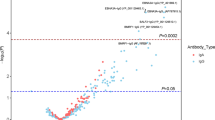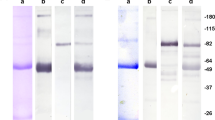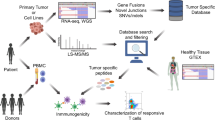Abstract
To identify tumor antigens for glioma, a human testis cDNA library was screened by serological identification of antigens by recombinant expression cloning with sera from glioma patients. In this screening, the most frequently isolated antigen was SOX6, an Sry-related high-mobility group (HMG) box-containing gene. SOX6 is a transcriptional factor that is specifically expressed in the developing central nervous system and in the early stages of chondrogenesis in mouse embryos. IgG antibodies against SOX6 were detected in sera from 12 of 36 glioma patients (33.3%), 0 of 14 patients with other brain disease (0%), and one of 54 other cancer patients (1.9%). In sera from 37 healthy individuals, no IgG responses against SOX6 were detected, except in an elderly female. Furthermore, Western blot and ELISA analyses with sera from glioma patients revealed that the DNA-binding domain, the HMG box of SOX6, might be a dominant epitope of IgGs against SOX6. RT–PCR and Northern blot analysis revealed that the SOX6 gene was more highly expressed in glioma tissues than in normal adult tissues, except testis. Western blot analysis with an anti-SOX6 antibody demonstrated that the SOX6 protein was expressed in glioma tissues, but not in normal adult brain tissue. Immunohistochemical analysis with the anti-SOX6 antibody showed that all the glioma tissues analysed expressed SOX6 in tumor cells, but only a few SOX6-positive cells were detected in non-neoplastic tissues from the cerebral cortex. In summary, these results indicate that the developmentally regulated transcription factor SOX6 is aberrantly expressed in glioma and specifically recognized by IgGs from glioma patients' sera.
This is a preview of subscription content, access via your institution
Access options
Subscribe to this journal
Receive 50 print issues and online access
$259.00 per year
only $5.18 per issue
Buy this article
- Purchase on Springer Link
- Instant access to full article PDF
Prices may be subject to local taxes which are calculated during checkout






Similar content being viewed by others

References
Almqvist PM, Mah R, Lendahl U, Jacobsson B and Hendson G . (2002). J. Histochem. Cytochem., 50, 147–158.
Bi W, Deng JM, Zhang Z, Behringer RR and de Crombrugghe B . (1999). Nat. Genet., 22, 85–89.
Brass N, Heckel D and Sahin U . (1997). Hum. Mol. Genet., 6, 33–39.
Brichard V, Van Pel A, Wolfel T, Wolfel C, De Plaen E, Lethe B, Coulie P and Boon T . (1993). J. Exp. Med., 178, 489–495.
Cattoretti G, Becker MH, Key G, Duchrow M, Schluter C, Galle J and Gerdes J . (1992). J. Pathol., 168, 357–363.
Chen YT, Scanlan MJ, Sahin U, Tureci O, Gure AO, Tsang S, Williamson B, Stockert E, Pfreundschuh M and Old LJ . (1997). Proc. Natl. Acad. Sci. USA, 94, 1914–1918.
Cohen-Barak O, Hagiwara N, Arlt MF, Horton JP and Brilliant MH. . (2001). Gene, 265, 157–164.
Connor F, Wright E, Denny P, Koopman P and Ashworth A . (1995). Nucleic Acids Res., 23, 3365–3372.
Fink L, Seeger W, Ermert L, Hanze J, Stahl U, Grimminger F, Kummer W and Bohle RM . (1998). Nat. Med., 4, 1329–1333.
Fischer U, Struss AK, Hemmer D, Pallasch CP, Steudel WI and Meese E . (2001). Clin. Exp. Immunol., 126, 206–213.
Hagiwara N, Klewer SE, Samson RA, Erickson DT, Lyon MF and Brilliant MH . (2000). Proc. Natl. Acad. Sci. USA, 97, 4180–4185.
Kamachi Y, Uchikawa M, Collignon J, Lovell-Badge R and Kondoh H . (1998). Development, 125, 2521–2532.
Kleihues P, Louis DN, Scheithauer BW, Rorke LB, Reifenberger G, Burger PC and Cavenee WK . (2002). J. Neuropathol. Exp. Neurol., 61, 215–225, discussion 226–229.
Lefebvre V, Li P and de Crombrugghe B . (1998). EMBO J., 17, 5718–5733.
Narahara M, Yamada A, Hamada-Kanazawa M, Kawai Y and Miyake M . (2002). Biol. Pharmacol Bull., 25, 705–709.
Old LJ and Chen YT . (1998). J. Exp. Med., 187, 1349–1354.
Pevny LH and Lovell-Badge R . (1997). Curr. Opin. Genet. Dev., 7, 338–344.
Pingault V, Bondurand N, Kuhlbrodt K, Goerich DE, Prehu MO, Puliti A, Herbarth B, Hermans-Borgmeyer I, Legius E, Matthijs G, Amiel J, Lyonnet S, Ceccherini I, Romeo G, Smith JC, Read AP, Wegner M and Goossens M . (1998). Nat. Genet., 18, 171–173.
Prados MDGP and Philips TL . (1992). Int. J. Radiat. Oncol. Biol. Phys., 23, 3–8.
Robbins PF, el-Gamil M, Kawakami Y, Stevens E, Yannelli JR and Rosenberg SA . (1994). Cancer Res., 54, 3124–3126.
Sahin U, Koslowski M, Tureci O, Eberle T, Zwick C, Romeike B, Moringlane JR, Schwechheimer K, Feiden W and Pfreundschuh M . (2000). Clin. Cancer Res., 6, 3916–3922.
Sahin U, Tureci O, Schmitt H, Cochlovius B, Johannes T, Schmits R, Stenner F, Luo G, Schobert I and Pfreundschuh M . (1995). Proc. Natl. Acad. Sci. USA, 92, 11810–11813.
Scanlan MJ, Chen YT and Williamson B . (1998). Int. J. Cancer, 76, 652–658.
Schilham MW, Oosterwegel MA, Moerer P, Ya J, de Boer PA, van de Wetering M, Verbeek S, Lamers WH, Kruisbeek AM, Cumano A and Clevers H . (1996). Nature, 380, 711–714.
Southard-Smith EM, Kos L and Pavan WJ . (1998). Nat. Genet., 18, 60–64.
Struss AK, Romeike BF, Munnia A, Nastainczyk W, Steudel WI, Konig J, Ohgaki H, Feiden W, Fischer U and Meese E . (2001). Oncogene, 20, 4107–4114.
Takahashi K, Shichijo S and Noguchi M . (1995). Cancer Res., 55, 3478–3482.
Toda M, Iizuka Y, Yu W, Imai T, Ikeda E, Yoshida K, Kawase T, Kawakami Y, Okano H and Uyemura K . (2001). Glia, 34, 1–7.
van der Bruggen P, Traversari C, Chomez P, Lurquin C, De Plaen E, Van den Eynde B, Knuth A and Boon T . (1991). Science, 254, 1643–1647.
Wagner T, Wirth J, Meyer J, Zabel B, Held M, Zimmer J, Pasantes J, Bricarelli FD, Keutel J and Hustert E . (1994). Cell, 79, 1111–1120.
Wegner M . (1999). Nucleic Acids Res., 27, 1409–1420.
Whitfield LS, Lovell-Badge R and Goodfellow PN . (1993). Nature, 364, 713–715.
Xia Y, Papalopulu N, Vogt PK and Li J . (2000). Cancer Res., 60, 6303–6306.
Yamashita A, Ito M, Takamatsu N and Shiba T . (2000). FEBS Lett., 481, 147–151.
Acknowledgements
This work was supported by grants from grants-in-aid for Scientific Research from the Ministry of Education, Culture, Sports, Science and Technology, Japan, and Keio Gijuku Academic Development Funds.
Author information
Authors and Affiliations
Corresponding author
Rights and permissions
About this article
Cite this article
Ueda, R., Iizuka, Y., Yoshida, K. et al. Identification of a human glioma antigen, SOX6, recognized by patients' sera. Oncogene 23, 1420–1427 (2004). https://doi.org/10.1038/sj.onc.1207252
Received:
Revised:
Accepted:
Published:
Issue Date:
DOI: https://doi.org/10.1038/sj.onc.1207252
Keywords
This article is cited by
-
Circulating anti-filamin C autoantibody as a potential serum biomarker for low-grade gliomas
BMC Cancer (2014)
-
Autologous antibody to src-homology 3-domain GRB2-like 1 specifically increases in the sera of patients with low-grade gliomas
Journal of Experimental & Clinical Cancer Research (2012)
-
Downregulation of KIF23 suppresses glioma proliferation
Journal of Neuro-Oncology (2012)
-
Identification of SOX2 as a novel glioma-associated antigen and potential target for T cell-based immunotherapy
British Journal of Cancer (2007)
-
Expression of a transcriptional factor, SOX6, in human gliomas
Brain Tumor Pathology (2004)


